2000 BMW 540I SEDAN steering
[x] Cancel search: steeringPage 149 of 217
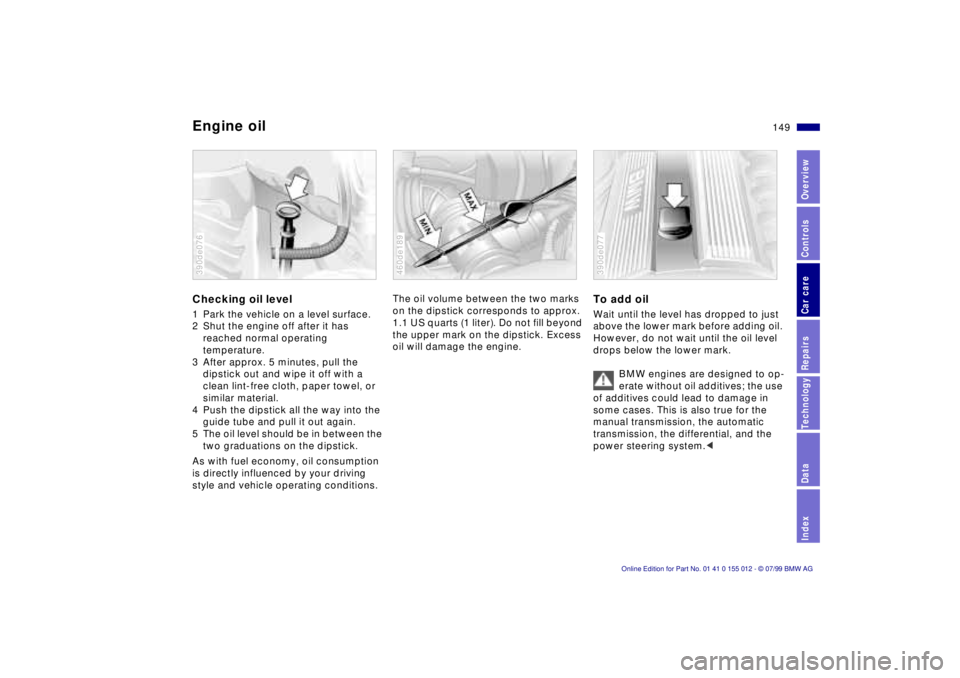
149n
RepairsIndexOverview Controls Car care Technology Data
Engine oilChecking oil level1 Park the vehicle on a level surface.
2 Shut the engine off after it has
reached normal operating
temperature.
3 After approx. 5 minutes, pull the
dipstick out and wipe it off with a
clean lint-free cloth, paper towel, or
similar material.
4 Push the dipstick all the way into the
guide tube and pull it out again.
5 The oil level should be in between the
two graduations on the dipstick.
As with fuel economy, oil consumption
is directly influenced by your driving
style and vehicle operating conditions.390de076
The oil volume between the two marks
on the dipstick corresponds to approx.
1.1 US quarts (1 liter). Do not fill beyond
the upper mark on the dipstick. Excess
oil will damage the engine.460de189
To add oilWait until the level has dropped to just
above the lower mark before adding oil.
However, do not wait until the oil level
drops below the lower mark.
BMW engines are designed to op-
erate without oil additives; the use
of additives could lead to damage in
some cases. This is also true for the
manual transmission, the automatic
transmission, the differential, and the
power steering system.< 390de077
Page 160 of 217
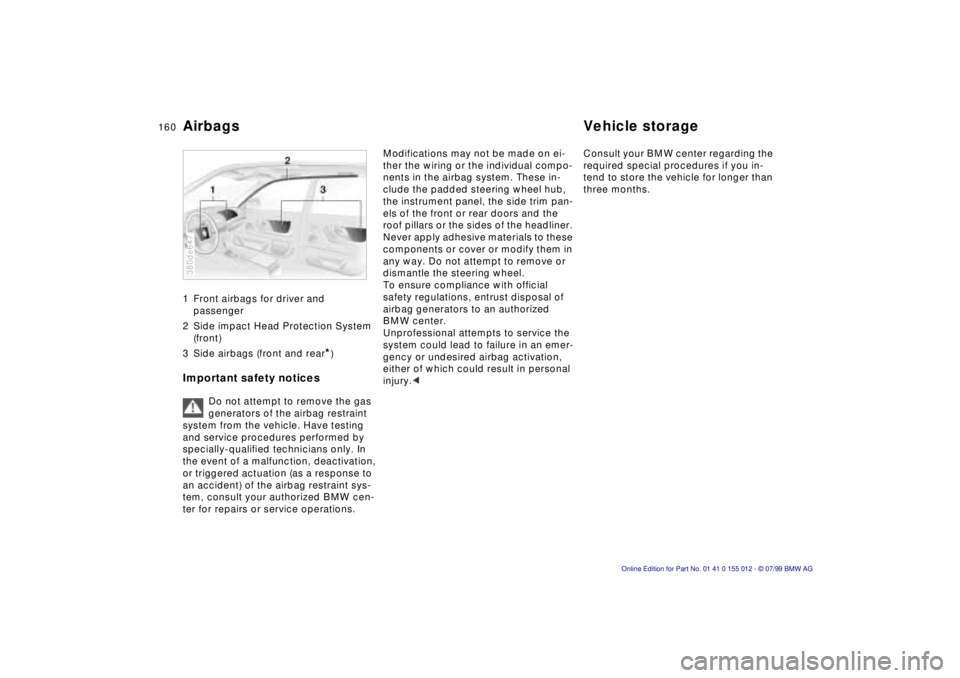
160n
Airbags Vehicle storage 1 Front airbags for driver and
passenger
2 Side impact Head Protection System
(front)
3 Side airbags (front and rear
*)
Important safety notices
Do not attempt to remove the gas
generators of the airbag restraint
system from the vehicle. Have testing
and service procedures performed by
specially-qualified technicians only. In
the event of a malfunction, deactivation,
or triggered actuation (as a response to
an accident) of the airbag restraint sys-
tem, consult your authorized BMW cen-
ter for repairs or service operations.
380de647
Modifications may not be made on ei-
ther the wiring or the individual compo-
nents in the airbag system. These in-
clude the padded steering wheel hub,
the instrument panel, the side trim pan-
els of the front or rear doors and the
roof pillars or the sides of the headliner.
Never apply adhesive materials to these
components or cover or modify them in
any way. Do not attempt to remove or
dismantle the steering wheel.
To ensure compliance with official
safety regulations, entrust disposal of
airbag generators to an authorized
BMW center.
Unprofessional attempts to service the
system could lead to failure in an emer-
gency or undesired airbag activation,
either of which could result in personal
injury.< Consult your BMW center regarding the
required special procedures if you in-
tend to store the vehicle for longer than
three months.
Page 173 of 217
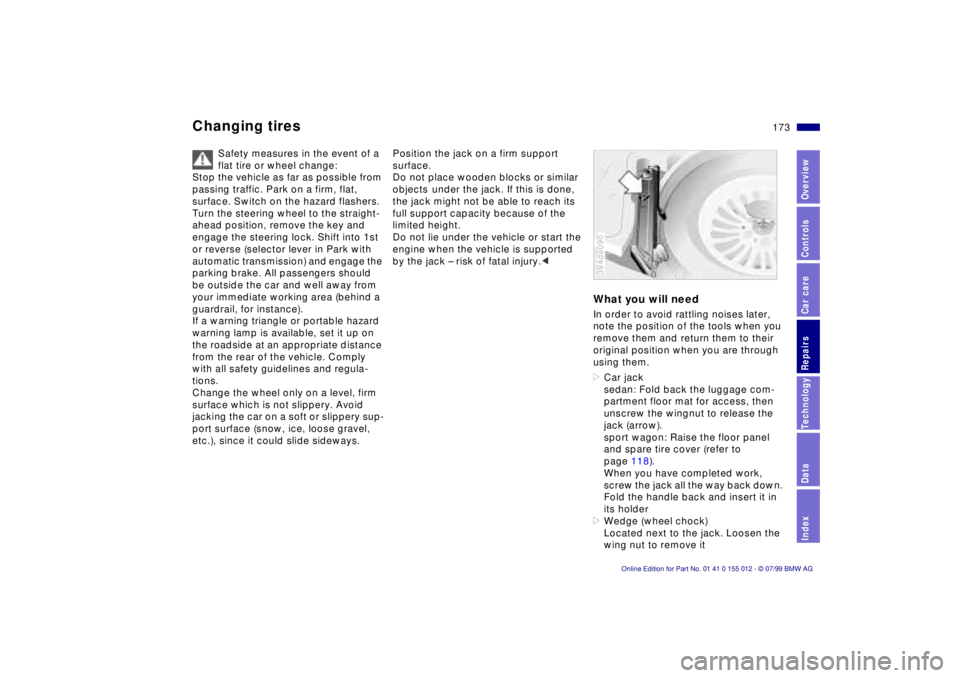
173n
RepairsIndexOverview Controls Car care Technology Data
Changing tires
Safety measures in the event of a
flat tire or wheel change:
Stop the vehicle as far as possible from
passing traffic. Park on a firm, flat,
surface. Switch on the hazard flashers.
Turn the steering wheel to the straight-
ahead position, remove the key and
engage the steering lock. Shift into 1st
or reverse (selector lever in Park with
automatic transmission) and engage the
parking brake. All passengers should
be outside the car and well away from
your immediate working area (behind a
guardrail, for instance).
If a warning triangle or portable hazard
warning lamp is available, set it up on
the roadside at an appropriate distance
from the rear of the vehicle. Comply
with all safety guidelines and regula-
tions.
Change the wheel only on a level, firm
surface which is not slippery. Avoid
jacking the car on a soft or slippery sup-
port surface (snow, ice, loose gravel,
etc.), since it could slide sideways.
Position the jack on a firm support
surface.
Do not place wooden blocks or similar
objects under the jack. If this is done,
the jack might not be able to reach its
full support capacity because of the
limited height.
Do not lie under the vehicle or start the
engine when the vehicle is supported
by the jack Ð risk of fatal injury.<
What you will needIn order to avoid rattling noises later,
note the position of the tools when you
remove them and return them to their
original position when you are through
using them.
>Car jack
sedan: Fold back the luggage com-
partment floor mat for access, then
unscrew the wingnut to release the
jack (arrow).
sport wagon: Raise the floor panel
and spare tire cover (refer to
page 118).
When you have completed work,
screw the jack all the way back down.
Fold the handle back and insert it in
its holder
>Wedge (wheel chock)
Located next to the jack. Loosen the
wing nut to remove it394de090
Page 176 of 217
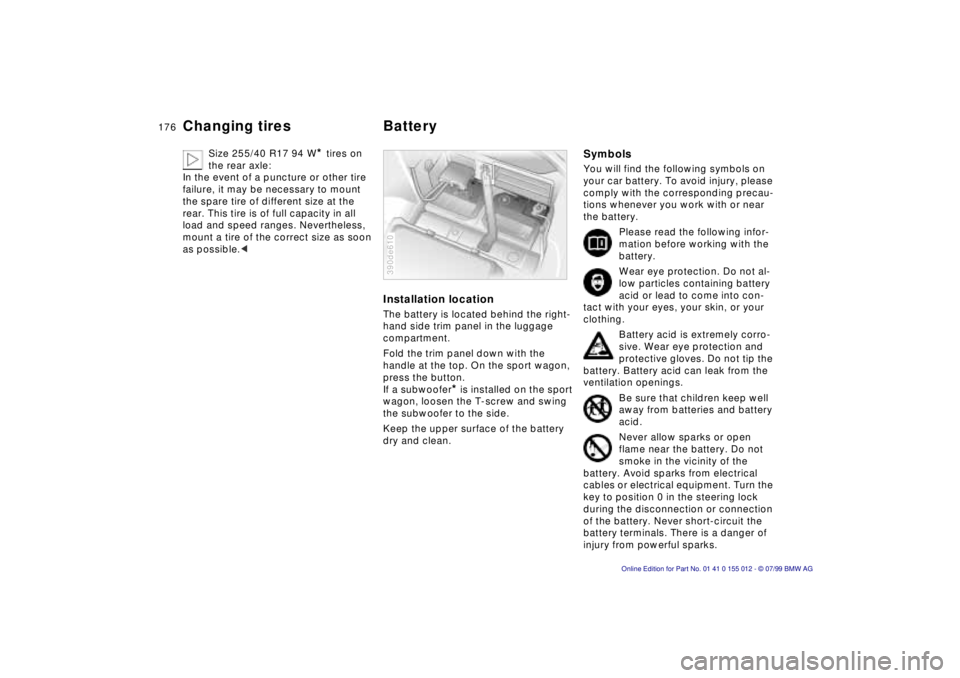
176n
Changing tires Battery
Size 255/40 R17 94 W
* tires on
the rear axle:
In the event of a puncture or other tire
failure, it may be necessary to mount
the spare tire of different size at the
rear. This tire is of full capacity in all
load and speed ranges. Nevertheless,
mount a tire of the correct size as soon
as possible.<
Installation locationThe battery is located behind the right-
hand side trim panel in the luggage
compartment.
Fold the trim panel down with the
handle at the top. On the sport wagon,
press the button.
If a subwoofer
* is installed on the sport
wagon, loosen the T-screw and swing
the subwoofer to the side.
Keep the upper surface of the battery
dry and clean.
390de610
SymbolsYou will find the following symbols on
your car battery. To avoid injury, please
comply with the corresponding precau-
tions whenever you work with or near
the battery.
Please read the following infor-
mation before working with the
battery.
Wear eye protection. Do not al-
low particles containing battery
acid or lead to come into con-
tact with your eyes, your skin, or your
clothing.
Battery acid is extremely corro-
sive. Wear eye protection and
protective gloves. Do not tip the
battery. Battery acid can leak from the
ventilation openings.
Be sure that children keep well
away from batteries and battery
acid.
Never allow sparks or open
flame near the battery. Do not
smoke in the vicinity of the
battery. Avoid sparks from electrical
cables or electrical equipment. Turn the
key to position 0 in the steering lock
during the disconnection or connection
of the battery. Never short-circuit the
battery terminals. There is a danger of
injury from powerful sparks.
Page 184 of 217
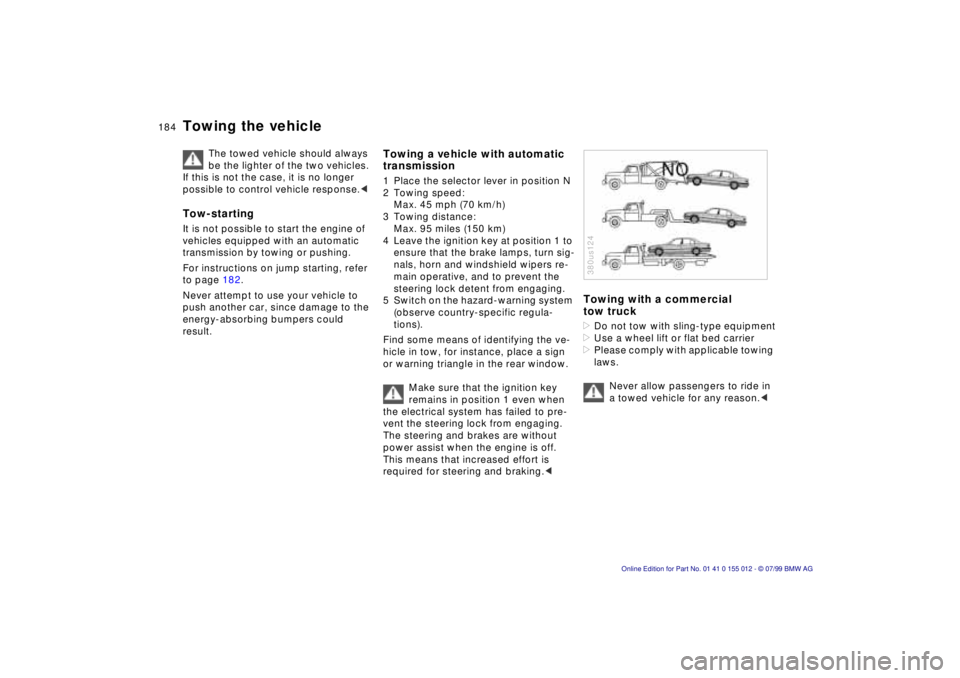
184n
Towing the vehicle
The towed vehicle should always
be the lighter of the two vehicles.
If this is not the case, it is no longer
possible to control vehicle response.<
Tow-startingIt is not possible to start the engine of
vehicles equipped with an automatic
transmission by towing or pushing.
For instructions on jump starting, refer
to page 182.
Never attempt to use your vehicle to
push another car, since damage to the
energy-absorbing bumpers could
result.
Towing a vehicle with automatic
transmission1 Place the selector lever in position N
2 Towing speed:
Max. 45 mph (70 km/h)
3 Towing distance:
Max. 95 miles (150 km)
4 Leave the ignition key at position 1 to
ensure that the brake lamps, turn sig-
nals, horn and windshield wipers re-
main operative, and to prevent the
steering lock detent from engaging.
5 Switch on the hazard-warning system
(observe country-specific regula-
tions).
Find some means of identifying the ve-
hicle in tow, for instance, place a sign
or warning triangle in the rear window.
Make sure that the ignition key
remains in position 1 even when
the electrical system has failed to pre-
vent the steering lock from engaging.
The steering and brakes are without
power assist when the engine is off.
This means that increased effort is
required for steering and braking.<
Towing with a commercial
tow truck>Do not tow with sling-type equipment
>Use a wheel lift or flat bed carrier
>Please comply with applicable towing
laws.
Never allow passengers to ride in
a towed vehicle for any reason.<380us124
Page 189 of 217

189n
RepairsIndexOverview Controls Car care Technology Data
In order to take driving conditions into
account, ATC registers corners and
both uphill and downhill gradients. For
example, if you maintain speed through
a curve, the transmission does not up-
shift.
On uphill gradients, it shifts only when
the engine speed increases in order to
make more efficient use of power
reserves. On downhill gradients ATC
downshifts when the speed of the vehi-
cles increases, causing the driver to
step on the brakes.Precision sensors monitor the number
of revolutions of the wheels. When
equipped with DSC, they also monitor
steering angle, lateral acceleration,
brake pressure and the movement of
the vehicle around its vertical axis.
If differences in the wheel speeds
occur, the system counteracts the dan-
ger of wheelspin by reducing torque. If
necessary, the system also responds
with additional applications of the
brakes at the rear wheels.
If the system detects an instability in the
vehicle's condition, the braking action
can also be directed to help the front
wheels by the DSC in order to help sta-
bilize the vehicle.
You may need some time to become
accustomed to this system intervention.
However, it guarantees optimum drive
force and driving stability.
The braking intervention may be
accompanied by a certain degree of
noise.ATC
*
ASC+T/DSC
*
Page 204 of 217

204n
Electrical system Drive beltsBattery 12 V, 90 AhSpark plugsNGK BKR 6 EQUP
Bosch FGR 7 DQP
(not released at this time)
This spark ignition system meets all
requirements of the Canadian Interfer-
ence-Causing Equipment Regulations
(ICES-2).BMW 528i:
Water pump Ð Alternator Ð
Power steering
V-belt 6 K x 1555
A/C compressor
V-belt 5 K x 906
BMW 540i:
Water pump Ð Alternator Ð
Power steering
V-belt 7 K x 1635
A/C compressor
V-belt 5 K x 1004You can obtain Original BMW
Parts and Accessories, as well as
professional advice from your autho-
rized BMW center.<
Page 208 of 217

A
ABS (Antilock Brake
System)23, 127
Accessories6
Activated-charcoal
filter103
Active seat53, 190
Adaptive Transmission
Control (ATC)71, 188
Add engine oil149
Add washer fluid148
Adjust backrest52
Adjust seats50
Adjust steering wheel54
Adjust temperature100
Air conditioning control98
Remove condensation
from windshields101
Air distribution100
Air pressure134
Air supply101
Air vent98
Airbags23, 60, 160, 188
Alarm system45
Antenna, Diversity190
Antennas133
Antifreeze151
Antifreeze, radiator130
Antilock Brake System
(ABS)23, 127
Anti-theft protection37
Approved gross vehicle
weight201Aquaplaning134
ASC+T/DSC24, 91, 189
Ashtray110
ATC (Adaptive Transmission
Control)71, 188
Attach vacuum cleaner111
AUC (Automatic recirculated-
air control)101
Automatic car washes155
Automatic climate control98
Automatic cruise control80
Automatic curb monitor56
Automatic dimming, interior
rearview mirror55
Automatic rear window
wiper79
Automatic recirculated-air
control (AUC)101
Automatic Stability Control
plus Traction/Dynamic
Stability Control (ASC+T)/
(DSC)24, 91, 189
Automatic steering wheel
adjustment54
Automatic transmission71
Automatic transmission with
Steptronic74
Automatic transmission, oil
capacities203
Average fuel
consumption88
Average speed88
Axle loads201
B
Backup lamps70
Bulb replacement169
Battery176, 204
Capacity204
Charging177
Discharged182
Removal and
installation178
Belts59
Beverage holder109
Blower101
BMW active seat53, 190
BMW comfort seat51
BMW sports seat52
BMW Universal
Transmitter105
Bore198
Brake system124
Brake faults130
Brake fluid152
Brake lamps, bulb
replacement169
Brake pads23
Breaking-in the
brakes124
Disc brakes124, 128
Parking brake23, 69
Brake-in procedure124
Brakes, refer to Brake
system
Breaking in the vehicle124
Break-resistant security
glass, care158
Bulb replacement167
C
Car jack173
Car keys35
Car Memory58
Car phones and telephones,
refer to the seperate
Owner's Manual
Car radio
reception133, 190
Car telephone109
Car wash155
Care, vehicle exterior156
Care, vehicle interior158
Cargo loading120
Caring for the vehicle
finish157
Catalytic converter126
Cellular phone133
Center (high-mount) brake
lamp, bulb
replacement171
Central locking system,
button40
Changing a tire173
Charging the battery177
Check air pressure30
Check Control85
Check engine oil level149
Child restraint systems59
Child's seat59
Child-safety locks66
Cigarette lighter110
Everything from A to Z